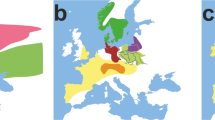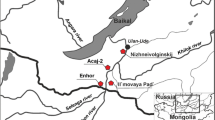Abstract
The discovery and excavations in 2006 by joint Russian–German–Mongolian expeditions of the Pazyryk culture burial sites (4th to 3rd centuries BC, Early Iron Age, the Scythian period) in the Altai mountains of northwestern Mongolia near the Russia border provided new material for studying various aspects of these ancient peoples lives, including human, animal and plant remains. Ice accumulation in the graves preserved the human remains, allowing biological analysis of the samples. We conducted a genetic study based on mitochondrial DNA from remains of three Pazyryk culture representatives to investigate the possible genetic relationships of this Siberian Scythian group with populations of adjacent territories. These data support possible genetic contacts between populations of Altai and other Eurasia regions in the Early Iron Age, and are in good agreement with corresponding archaeological and anthropological data. However, a large-scale study of the Pazyryk population gene pool structure must be performed to further confirm these findings.
Similar content being viewed by others
Abbreviations
- mtDNA:
-
Mitochondrial DNA
- HVR:
-
Hyper-variable region
- RFLP:
-
Restriction fragments length polymorphism
- GuSCN:
-
Guanidinium thiocyanate
- OKG:
-
Olon-Kurin-Gol
- PCR:
-
Polymerase chain reaction
- rCRS:
-
Revised Cambridge Reference Sequence
References
Adcock GJ, Dennis ES, Easteal S, Huttley GA, Jermiin LS, Peacock WJ, Thorne A (2001) Mitochondrial DNA sequences in ancient Australians: Implications for modern human origins. Proc Natl Acad Sci USA 98:537–542
Andrews RM, Kubacka I, Chinnery PF, Lightowiers RN, Turnbull DM, Howell N (1999) Reanalysis and revision of Cambridge reference sequence for human mitochondrial DNA. Nat Genet 23:147
Bramanti B, Thomas MG, Haak W, Unterlaender M, Jores P, Tambets K, Antanaitis-Jacobs I, Haidle MN, Jankauskas R, Kind C-J, Lueth F, Terberger T, Hiller J, Matsumura S, Forster P, Burger J (2009) Genetic discontinuity between local hunter-gatherers and central Europe’s first farmers. Science 326:137–140
Chikisheva TA, Gubina MA, Kulikov IV, Karafet TM, Voevoda MI, Romaschenko AG (2007) A paleogenetic study of the prehistoric populations of the Altai. Archaeol Ethnol Anthropol Eurasia 32:130–142
Clisson I, Keyser C, Francfort H-P, Crubezy E, Samashev Z, Ludes B (2002) Genetic analysis of human remains from a double inhumation in a frozen kurgan in Kazakhstan (Berel site, Early 3rd Century BC). Int J Legal Med 116:304–308
Comas D, Calafell F, Mateu E, Perez-Lezaun A, Bosch E, Martinez-Arias R, Clarimon J, Facchini F, Fiori G, Luiselli D, Pettener D, Bertranpetit J (1998) Trading genes along the Silk Road: mtDNA sequences and the origin of Central Asian populations. Am J Hum Genet 63:1824–1838
Ermini L, Olivieri C, Rizzi E, Corti G, Bonnal R, Soares P, Luciani S, Marota I, De Bellis G, Richards MB, Rollo F (2008) Complete mitochondrial genome sequence of the Tyrolean Iceman. Curr Biol 18:1687–1693
Jung Y-H, Han S-H, Shin T, Oh M-Y (2002) Genetic characterization of horse bone excavated from the Kwakji archaeological site, Seju, Korea. Mol Cells 14:224–230
Keyser-Tracqui C, Blandin-Frappin P, Francfort HP, Ricaut FX, Lepetz C, Crubezy E, Samashev Z, Ludes B (2005) Mitochondrial DNA analysis of horses recovered from a frozen tomb (Berel site, Kazakhstan, 3rd Century BC). Anim Genet 36:203–209
Lalueza-Fox C, Sampietro ML, Gilbert MTP, Castri L, Facchini F, Pettener D, Bertranpetit J (2004) Unravelling migrations in the steppe: mitochondrial DNA sequences from ancient Central Asians. Proc Biol Sci 271:941–947
Mitchell D, Willerslev E, Hansen A (2005) Damage and repair of ancient DNA. Mut Res 571:265–276
Molodin VI (2007) Issledovanija Rossiysko-Germansko-Mongolskoi ekspedicii na severo-zapade Mongolii letom 2006 g. Rossiyskaja Arkheologiya 4:42–50
Molodin VI, Voevoda MI, Chikisheva TA, Romaschenko AG, Polosmak NV, Shulgina EO, Nefedova MV, Kulikov IV, Damba LD, Gubina MA, Kobzev VF (2003) The Gotny Altai population in the Early Iron Age as an ethnocultural phenomenon (Archaeological, Anthropological and Genetic Perspectives). Siberian Branch of the Russian Academy of Sciences, Novosibirsk
Molodin VI, Parzinger H, Ceveendorz D (2009) Das Kriegergrab von Olon-Kurin-Gol. In: Ausstellungskatalog der Zeichen des Goldenen Greifen,. Konigsgraber der Skythen. Museum für Vor- und Frühgeschichte Staatliche Museen, Berlin Berlin, pp 148–156
Parzinger H, Molodin V, Ceveendorz D (2008) Der Skythenzeitliche Krieger aus dem Eis: Neue entdeckungen im Mongolischen Altaj. Amsterdam
Pilipenko AS, Romaschenko AG, Molodin VI, Kulikov IV, Kobzev VF, Pozdnyakov DV, Novikova OI (2008) Infant burials in dwellings at Chicha-1, in the Baraba forest-steppe: results of DNA analysis. Archaeol Ethnol Anthropol Eurasia 34:57–67
Polosmak NV, Barkova LL (2005) Kostjum I tekstil pazyrykcev Altaja (IV-III vv. do n.e.). INFOLIO, Novosibirsk
Polosmak NV, Kundo LP, Balakina GG, Mamatyuk VI, Vasilyev VG, Karpova EV, Malakhov VV, Vlasov AA, Kraevskaya IL, Dovlitova LS, Korolyuk EA, Tsareva EG (2006) Textiles from the “frozen” tombs in Gorny Altai 400–300 BC (An Integrate Study). Siberian Branch of the Russian Academy of Sciences, Novosibirsk
Quintana-Murci L, Chaix R, Wells RS, Behar DM, Sayar H, Scozzari R, Rengo C, Al-Zahery N, Semino O, Santachiara-Benerecetti AS, Coppa A, Ayub Q, Mohyuddin A, Tyler-Smith C, Mehdi SQ, Torroni A, McElreavey K (2004) Where West Meets East: The Complex mtDNA Landscape of the Southwest and Central Asian Corridor. Am J Hum Genet 74:827–845
Richards MB, Macaulay VA, Bandelt H-J, Sykes BC (1998) Phylogeography of mitochondrial DNA in western Europe. Ann Hum Genet 62:241–260
Richards M, Macaulay V, Hickey E, Vega E, Sykes B, Guida V, Rengo C, Sellito D, Cruciani F, Kivisild T, Villems R, Thomas M, Rychkov S, Rychkov O, Rychkov Y, Golge M, Dimitrov D, Hill E, Bradley D, Romano V, Cali F, Vona G, Demaine A, Papiha S, Triantaphyllidis C, Stefanescu G, Hatina J, Belledi M, Di Rienzo A, Novelletto A, Oppenheim A, Norby S, Al-Zaheri N, Santachiara-Benerecetti S, Scozzari R, Torroni A, Bandelt H-J (2000) Tracing European founder lineages in the Near Eastern mtDNA pool. Am J Hum Genet 67:1251–1276
Rudenko SI (1968) Drevneishie v mire hudojestvennie kovri I tkani. Moscow
Torroni A, Huoponen K, Francalacci P, Petrozzi M, Morelli L, Scozzari R, Obinu D, Savontaus M-L, Wallace DC (1996) Classification of European mtDNAs from an analysis of three European populations. Genetics 144:1835–1850
Voevoda MI, Sitnikova VV, Chikisheva TA, Romashchenko AG, Polosmak NV, Molodin VI, Derevianko AP, Shumniy VK (1998) Molecular genetic analysis of mitochondrial DNA of representatives of Pazyryk culture of Altai (IV-II centuries B.C.). Dokl Akad Nauk 358:564–566
Xu X, Arnason U (1994) The complete mitochondrial DNA sequence of the horse, Equus caballus: extensive heteroplasmy of the control region. Gene 148:357–362
Yao Y-G, Kong Q-P, Wang C-Y, Zhu C-L, Zhang Y-P (2004) Different matrilineal contributions to genetic structure of ethnic groups in the Silk Road region in China. Mol Biol Evol 21:2265–2280
Acknowledgements
The research was supported by grants from the Russian Foundation for Basic Research (09-06-00357a) and Complex Interdisciplinary N 115 from Siberian Branch of the Russian Academy of Sciences. The authors are grateful to I.Y. Slusarenko and K.W. Hoisner for providing the dendrochronological data.
Author information
Authors and Affiliations
Corresponding author
Additional information
The research was supported by grants from the Russian Foundation for Basic Research (09-06-00357a 10-06-00406а), Russian Humanity Scientific Foundation (10-01-00193а) and Complex Interdisciplinary Project N 115 from Siberian Branch of the Russian Academy of Sciences.
Electronic supplementary material
Below is the link to the electronic supplementary material.
Supplementary Table 1
(PPT 104 kb)
Rights and permissions
About this article
Cite this article
Pilipenko, A.S., Romaschenko, A.G., Molodin, V.I. et al. Mitochondrial DNA studies of the Pazyryk people (4th to 3rd centuries BC) from northwestern Mongolia. Archaeol Anthropol Sci 2, 231–236 (2010). https://doi.org/10.1007/s12520-010-0042-z
Received:
Accepted:
Published:
Issue Date:
DOI: https://doi.org/10.1007/s12520-010-0042-z




